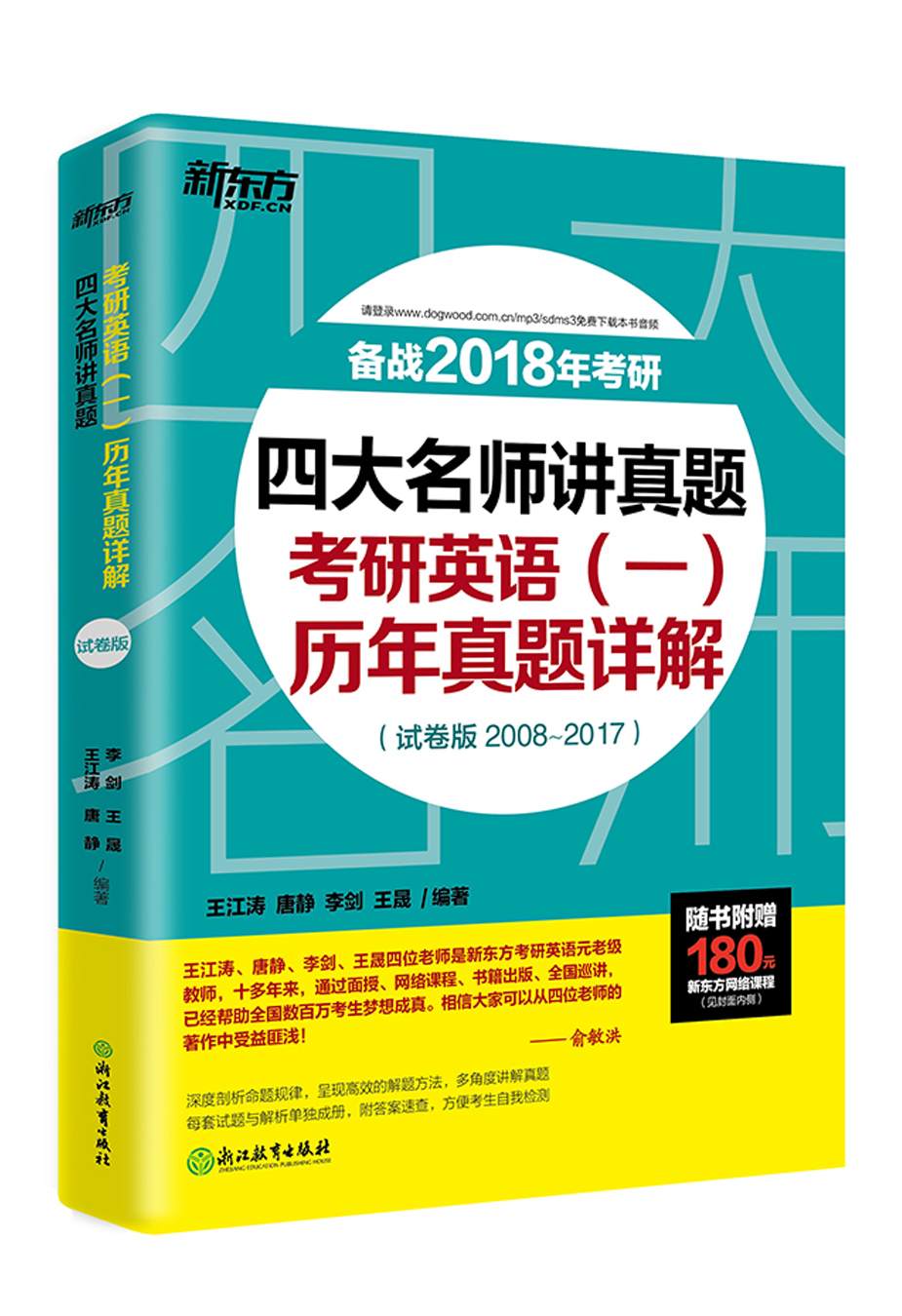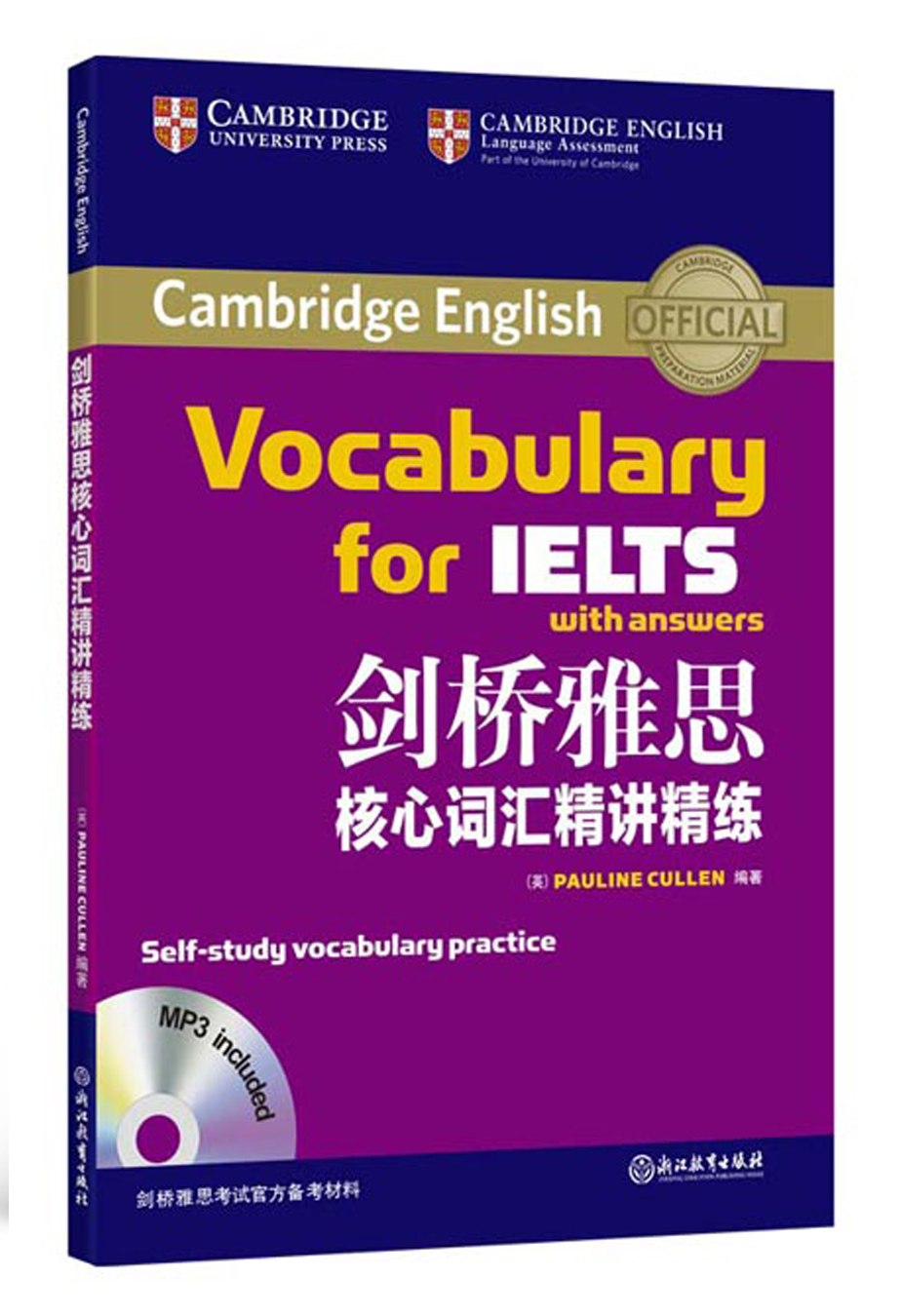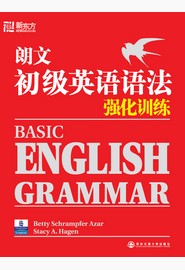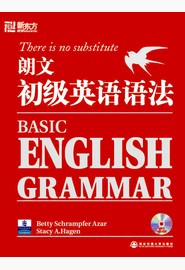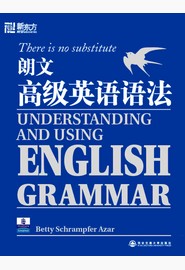朗文高级英语语法强化训练
其它购书方式: 新东方书友会邮购
读者,您好!如遇到音频无法下载的情况,请您及时与我们的维护人员联系,联系电话:62605588-188。
相关图书
编辑推荐
《朗文英语语法》系列是专门为英语学习者量身定做的一套语法教材,分为初级、中级、高级三个级别,并配有相应得强化训练册。该系列教材自20世纪80年代出版以来,深受广大英语学习者喜爱,在国际上享有盛誉。
《朗文高级英语语法强化训练》是《朗文高级英语语法》的配套练习册,它针对《朗文高级英语语法》各章节中的重要语法点设计了丰富、多样的练习,为学习者提供了大量在真实语境中练习运用语法规则的机会,使学习者能够通过循序渐进的学习,逐步提高准确、独立、创造性地运用语法知识进行交际实践的能力。
本练习册不仅可以满足学生自学英语语法的要求,也可以作为辅导教材,用于课堂教学、家庭作业、考试和课堂辅导。
译序:
作为世界上最畅销的英语语法教材之一,《朗文英语语法》系列教材在培养中国学生的英语实际应用能力方面,开创了一个全新的视野和学习思路。
许多在国外畅销的语法教材,来到国内都面临着叫好不叫座的尴尬。究其原因,主要是因为国内的英语课堂教学模式使大部分学生对语法的认识停留在课堂笔记中,对语法的应用止步于单项选择题。随之而来的是,语法既是学生的强项,同时又成了一大弊病—太多的条条框框成为阻碍学生自由表达的桎梏,缺乏输出方面的引导和有效的训练使得英语语法的诸多细则无法被“盘活”。久而久之,学生的英语思维越来越僵化,在以交流为导向的国外主流语言教材面前变得无所适从。所以,一套好的语法教材,不仅应该能够简单扼要、提纲挈领地讲解语法规则,而且要能够将语法知识与其在真实语言环境中的实际应用紧密地结合起来,让学生真正体会到语法学习的成就感和趣味性,就这一点来说,《朗文英语语法》系列带给我们许多有益的启示。
首先,这套教材根据不同级别的学生的水平和需求,对纷繁复杂的英语语法点进行了合理的梳理和编排,使学 生可以结合自己的实际情况循序渐进地轻松掌握语法知识。其次,对语法规则的叙述和讲解可读性极强,通俗易懂,学起来不会让人感到枯燥乏味。再次,每个语法点都配备了形式多样的练习,这些练习均源自一个朴素的教学理念,即“应用和沟通是语言学习的最终目的”。通过这些基于真实语境的练习,学生可以在实际应用中不断加深对语法规则的记忆和理解,学习效率也会随之大大提高。
另外,这套教材的每个级别都配有对应的强化训练册。建议大家对练习的内容要力争做到熟读、口头复述甚至改写,这种看似单调的训练方法却是最直接有效的,可以帮助大家从认知到模仿,直至最后能够诠释自己的生活,在有效重复中逐渐完成从量变到质变,最终体会语言应用的最高境界,即语感(linguistic intuition)。
美国人说:“Use the word three times, and it’s yours.”我们始终坚信,英语语法不是“学”出来的,而是“用”出来的。希望大家在语法学习中也能化被动接受为主动表达,在反复的练习中体会把枯燥的语言规则转化为自如交流的快乐!
译者
于北京新东方学校
前言:
《朗文高级英语语法》(Understanding and using English Grammar)是一本专门为中级水平的英语学习者提高语法技能而量身定做的教材。本书以语法为核心,同时通过各种方法帮助学习者全面提升各项语言技能。本书既可以用作课堂教材,也可以作为参考资料供学生自学。
和以往的版本相比,第三版不仅保留了折衷教学法(eclectic approach)和大量多样的练习,而且在多个方面进行了充实:
● 进一步扩充了交流方面的内容,且表述得更加清晰、明确。教材中有大量“真实交 流”的机会供教师利用。这些内容以学生的生活经历为语言环境,从中选取有趣的话题,激励学生通过有组织的开放式讨论来自由地表达自己的观点。设置这种活动主要是基于很多经验丰富的教师们的观点,即以语法为基础的学习与通过口语交流来学习不是相互排斥的,而是相互促进的,这两种方式可以在同一个语言教程中、同一个班上,甚至同一节课上一起使用并且能够相互促进。
● 更加注重互动性。第三版教材将许多以前标有“口语”或“口语(合上书)”的内容,重新编排成更容易操作的两人练习或小组练习。当然,在教师的带领下也可以进行全班练习。第三版教材鼓励互动,同时也给使用者留出了足够的空间,让其自行决定什么程度的互动最适合他们的需要。
● 练习的种类更加丰富。第三版教材增加了自由回答练习和开放式交流任务,依旧提供大量控制性练习题,以加深学生对要学习的语法结构的形式、意义和用法的最初理解。同时,还包括了更多的写作话题、口语活动、错误分析练习和情景扩展练习。
● 篇幅较长的章节已经被拆分成了较短的章节,某些语法单元也进行了重新编排。
《朗文高级英语语法强化训练》是《朗文高级英语语法》的配套练习册,它针对《朗文高级英语语法》中各章节的重要语法点设计了广泛而多样的练习,为各层次的学习者提供了丰富而实用的实践机会。而且它在强调学习语法知识的同时,也注重其他各种语言技能的提高,使学生通过逐步学习语法知识提高自身正确、有效使用英语的能力。
此练习册的内容和设计不仅满足了学生自学英语语法的要求,而且也可以作为教师的辅助材料,用于课堂教学、家庭作业、考试和课堂辅导。
第三版教材封面上有一只展翅高飞的燕子。在世界各地都能看到燕子的身影,它们是快乐、顽皮、生机勃勃的鸟儿,它们的来去往往预示着季节的转换。这只燕子标志着新的开始——学生、教师和教材的编者携手并进,踏上新的语言学习之路。
《朗文高级英语语法强化训练》是《朗文高级英语语法》的配套练习册,它针对《朗文高级英语语法》各章节中的重要语法点设计了丰富、多样的练习,为学习者提供了大量在真实语境中练习运用语法规则的机会,使学习者能够通过循序渐进的学习,逐步提高准确、独立、创造性地运用语法知识进行交际实践的能力。
本练习册不仅可以满足学生自学英语语法的要求,也可以作为辅导教材,用于课堂教学、家庭作业、考试和课堂辅导。
译序:
作为世界上最畅销的英语语法教材之一,《朗文英语语法》系列教材在培养中国学生的英语实际应用能力方面,开创了一个全新的视野和学习思路。
许多在国外畅销的语法教材,来到国内都面临着叫好不叫座的尴尬。究其原因,主要是因为国内的英语课堂教学模式使大部分学生对语法的认识停留在课堂笔记中,对语法的应用止步于单项选择题。随之而来的是,语法既是学生的强项,同时又成了一大弊病—太多的条条框框成为阻碍学生自由表达的桎梏,缺乏输出方面的引导和有效的训练使得英语语法的诸多细则无法被“盘活”。久而久之,学生的英语思维越来越僵化,在以交流为导向的国外主流语言教材面前变得无所适从。所以,一套好的语法教材,不仅应该能够简单扼要、提纲挈领地讲解语法规则,而且要能够将语法知识与其在真实语言环境中的实际应用紧密地结合起来,让学生真正体会到语法学习的成就感和趣味性,就这一点来说,《朗文英语语法》系列带给我们许多有益的启示。
首先,这套教材根据不同级别的学生的水平和需求,对纷繁复杂的英语语法点进行了合理的梳理和编排,使学 生可以结合自己的实际情况循序渐进地轻松掌握语法知识。其次,对语法规则的叙述和讲解可读性极强,通俗易懂,学起来不会让人感到枯燥乏味。再次,每个语法点都配备了形式多样的练习,这些练习均源自一个朴素的教学理念,即“应用和沟通是语言学习的最终目的”。通过这些基于真实语境的练习,学生可以在实际应用中不断加深对语法规则的记忆和理解,学习效率也会随之大大提高。
另外,这套教材的每个级别都配有对应的强化训练册。建议大家对练习的内容要力争做到熟读、口头复述甚至改写,这种看似单调的训练方法却是最直接有效的,可以帮助大家从认知到模仿,直至最后能够诠释自己的生活,在有效重复中逐渐完成从量变到质变,最终体会语言应用的最高境界,即语感(linguistic intuition)。
美国人说:“Use the word three times, and it’s yours.”我们始终坚信,英语语法不是“学”出来的,而是“用”出来的。希望大家在语法学习中也能化被动接受为主动表达,在反复的练习中体会把枯燥的语言规则转化为自如交流的快乐!
译者
于北京新东方学校
前言:
《朗文高级英语语法》(Understanding and using English Grammar)是一本专门为中级水平的英语学习者提高语法技能而量身定做的教材。本书以语法为核心,同时通过各种方法帮助学习者全面提升各项语言技能。本书既可以用作课堂教材,也可以作为参考资料供学生自学。
和以往的版本相比,第三版不仅保留了折衷教学法(eclectic approach)和大量多样的练习,而且在多个方面进行了充实:
● 进一步扩充了交流方面的内容,且表述得更加清晰、明确。教材中有大量“真实交 流”的机会供教师利用。这些内容以学生的生活经历为语言环境,从中选取有趣的话题,激励学生通过有组织的开放式讨论来自由地表达自己的观点。设置这种活动主要是基于很多经验丰富的教师们的观点,即以语法为基础的学习与通过口语交流来学习不是相互排斥的,而是相互促进的,这两种方式可以在同一个语言教程中、同一个班上,甚至同一节课上一起使用并且能够相互促进。
● 更加注重互动性。第三版教材将许多以前标有“口语”或“口语(合上书)”的内容,重新编排成更容易操作的两人练习或小组练习。当然,在教师的带领下也可以进行全班练习。第三版教材鼓励互动,同时也给使用者留出了足够的空间,让其自行决定什么程度的互动最适合他们的需要。
● 练习的种类更加丰富。第三版教材增加了自由回答练习和开放式交流任务,依旧提供大量控制性练习题,以加深学生对要学习的语法结构的形式、意义和用法的最初理解。同时,还包括了更多的写作话题、口语活动、错误分析练习和情景扩展练习。
● 篇幅较长的章节已经被拆分成了较短的章节,某些语法单元也进行了重新编排。
《朗文高级英语语法强化训练》是《朗文高级英语语法》的配套练习册,它针对《朗文高级英语语法》中各章节的重要语法点设计了广泛而多样的练习,为各层次的学习者提供了丰富而实用的实践机会。而且它在强调学习语法知识的同时,也注重其他各种语言技能的提高,使学生通过逐步学习语法知识提高自身正确、有效使用英语的能力。
此练习册的内容和设计不仅满足了学生自学英语语法的要求,而且也可以作为教师的辅助材料,用于课堂教学、家庭作业、考试和课堂辅导。
第三版教材封面上有一只展翅高飞的燕子。在世界各地都能看到燕子的身影,它们是快乐、顽皮、生机勃勃的鸟儿,它们的来去往往预示着季节的转换。这只燕子标志着新的开始——学生、教师和教材的编者携手并进,踏上新的语言学习之路。
作者简介
Betty Schrampfer Azar ——
从事英语语言教学研究和语法教材编写工作四十余年,对英语语法体系及语法教学有深入的研究和独到的见解,出版过多部经典语法教材。
从事英语语言教学研究和语法教材编写工作四十余年,对英语语法体系及语法教学有深入的研究和独到的见解,出版过多部经典语法教材。
图书目录
第一章 动词时态概述 (Overview Of Verb Tenses)
1. 动词时态 (Verb Tenses) 1
2. 动词时态 (Verb Tenses) 2
3. -ing和-ed形式的拼写 (Spelling of -ing and -ed Forms) 4
第二章 一般现在时,一般过去时,现在进行时和过去进行时(Present And Past,Simple And Progressive)
1. 一般现在时和现在进行时 (The Simple Present and the Present Progressive) 5
2. 静态动词与动态动词的比较 (Stative vs. Progressive Verbs) 6
3. 一般现在时和现在进行时 (The Simple Present and the Present Progressive) 7
4. -ed 的发音 (Pronunciation of -ed) 8
5. 不规则动词 (Irregular Verbs) 9
6. 不规则动词的过去式 (Simple Past of Irregular Verbs) 11
7. 不规则动词的过去式 (Simple Past of Irregular Verbs) 12
8. 不规则动词的过去式 (Simple Past of Irregular Verbs) 13
9. 不规则动词的过去式 (Simple Past of Irregular Verbs) 14
10. 易混淆的动词:raise/rise, set/sit, lay/lie (Troublesome Verbs: raise/rise, set/sit, lay/lie) 14
11. 一般过去时和过去进行时 (The Simple Past and the Past Progressive) 15
12. 一般过去时和过去进行时 (The Simple Past and the Past Progressive) 16
13. 一般过去时和过去进行时 (The Simple Past and the Past Progressive) 17
第三章 完成时和完成进行时(Perfect And Perfect Progressive Tenses)
1. 现在完成时 (The Present Perfect) 18
2. since和for的用法 (Using since and for) 19
3. 一般过去时和现在完成时 (The Simple Past and the Present Perfect) 20
4. 现在完成时和现在完成进行时 (The Present Perfect and the Present Perfect Progressive) 20
5. 现在完成时和现在完成进行时 (The Present Perfect and the Present Perfect Progressive) 21
6. 一般过去时和过去完成时 (The Simple Past and the Past Perfect) 22
7. 一般过去时和过去完成时 (The Simple Past and the Past Perfect) 23
8. 现在完成进行时和过去完成进行时 (The Present Perfect Progressive and the Past Perfect Progressive) 25
第四章 将来时(Future Time)
1. will与be going to的比较 (Will vs. be going to) 26
2. 在时间状语从句中表示将来 (Expressing the Future in Time Clauses) 27
3. 用现在进行时表示将来 (Using the Present Progressive to Express Future Time) 29
4. 将来进行时 (Future Progressive) 29
5. 将来完成时和将来完成进行时 (The Future Perfect and the Future Perfect Progressive) 30
第五章 时间状语从句和动词时态总结 (Adverb Clauses Of Time And Summary Of Verb Tenses)
1. 时间状语从句 (Adverb Clauses of Time) 31
2. 时间状语从句 (Adverb Clauses of Time) 32
3. 时间状语从句中动词的时态 (Verb Tenses in Adverb Clauses of Time) 32
4. 动词时态复习 (Verb Tense Review) 33
5. 动词时态复习 (Verb Tense Review) 34
6. 动词时态复习 (Verb Tense Review) 35
7. 动词时态复习 (Verb Tense Review) 35
8. 测试A:动词时态 (Test A: Verb Tenses) 38
9. 测试B:动词时态 (Test B: Verb Tenses) 40
第六章 主谓一致(Subject-Verb Agreement)
1. 预习:主谓一致 (Preview: Subject-verb Agreement) 42
2. -s/-es的发音和拼写 (Pronunciation and Spelling of Final -s/-es) 42
3. 基本的主谓一致问题 (Basic Subject-verb Agreement) 43
4. 主谓一致:表达数量 (Subject-verb Agreement: Using Expressions of Quantity) 43
5. 主谓一致: there + be和一些不规则表达的用法 (Subject-verb Agreement: Using there + be and Some Irregularities) 44
6. 主谓一致 (Subject-verb Agreement) 44
第七章 名词 (Nouns)
1. -s/-es结尾 (Final -s/-es) 46
2. 复数名词 (Plural Nouns) 47
3. 外来名词的不规则复数形式 (Irregular Foreign Plurals) 47
4. 所有格 (Possessive Nouns) 48
5. 撇号(’)的用法 (Using Apostrophes) 49
6. 名词作修饰语 (Using Nouns as Modifiers) 49
7. 名词作修饰语 (Using Nouns as Modifiers) 50
8. 可数名词和不可数名词 (Count and Noncount Nouns) 51
9. 冠词的用法 (Using Articles) 53
10. 数量的表达 (Expressions of Quantity) 55
11. a few和few,a little和little的用法 (Using a few/few; a little/little) 56
12. 带of的数量表达 (Using of in Expressions of Quantity) 56
13. one,each,every的用法 (Using one, each, every) 58
第八章 代词 (Pronouns)
1. 人称代词 (Personal Pronouns) 59
2. 代词的一致 (Pronoun Agreement) 60
3. 反身代词 (Reflexive Pronouns) 60
4. 代词的一致 (Pronoun Agreement) 62
5. other的形式 (Forms of other) 62
6. 名词和代词 (Nouns and Pronouns) 64
7. 测试A:名词和代词 (Test A: Nouns and Pronouns) 65
8. 测试B:名词和代词 (Test B: Nouns and Pronouns) 67
第九章 情态动词(一) (Modals, Part 1)
1. 情态动词后的动词形式 (Verb Forms with Modal Auxiliaries) 69
2. 礼貌请求 (Making Polite Requests) 70
3. would you mind的用法 (Using would you mind) 70
4. must (not)和(do not) have to 〔Must (not) and (do not) have to〕 71
5.动词形式复习:have to (Verb Form Review: have to) 72
6. should, ought to, had better 73
7. be supposed to 74
8. be supposed to 74
9. let’s, why don’t, shall I/we 75
10. 用could和should提建议 (Using could and should to Make Suggestions) 76
第十章 情态动词(二) (Modals, Part 2)
1. 表示确定程度:must和may/might/could
(Degrees of Certainty: must and may/might/could) 78
2. 情态动词的形式 (Forms of Modals) 79
3. 表示结论:must和must not (Making Conclusions: must and must not) 80
4. 表示能力:can和could (Ability: can and could) 81
5. 表示重复性动作:would (Repeated Action: would) 82
6. would rather 83
7. 测试A:情态动词和短语情态动词 (Test A: Modals and Phrasal Modals) 84
8. 测试B:情态动词和短语情态动词 (Test B: Modals and Phrasal Modals) 86
第十一章 被动语态 (The Passive)
1. 被动语态的构成 (Forming the Passive) 88
2. 被动语态的构成:疑问句、否定句和肯定句
(Forming the Passive: Questions, Negative, and Affirmative) 89
3. 被动语态的构成 (Forming the Passive) 89
4. 被动语态的用法:及物动词与不及物动词的比较
(Using the Passive: Transitive vs. Intransitive Verbs) 91
5. 被动语态的构成 (Forming the Passive) 91
6. 主动语态与被动语态的比较 (Active vs. Passive) 92
7. by短语的用法 (Using the by-phrase) 93
8. 间接宾语用作被动语态的主语 (Indirect Objects as Passive Subjects) 94
9. 主动语态和被动语态 (Active and Passive) 94
10. 现在分词与过去分词的比较 (The Present Participle vs.the Past Participle) 96
11. 现在分词与过去分词的比较 (The Present Participle vs.the Past Participle) 97
12. 情态动词的被动语态 (Passive Modals) 97
13. 情态动词的被动语态 (Passive Modals) 98
14. 情态动词的被动语态 (Passive Modals) 99
15. 静态被动语态 (Stative Passive) 101
16. 静态被动语态 (Stative Passive) 102
17. 静态被动语态 + 介词 (Stative Passive + Prepositions) 103
18. 现在分词与过去分词的比较 (Present vs.Past Participles) 104
19. get与被动语态 (The Passive with get) 105
20. get与被动语态 (The Passive with get) 106
21. 分词形容词 (Participial Adjectives) 107
22. 分词形容词 (Participial Adjectives) 108
23. 动词形式复习:主动和被动 (Verb Form Review: Active and Passive) 109
24. 测试A:被动语态 (Test A: The Passive) 112
25. 测试B:被动语态 (Test B: The Passive) 114
第十二章 名词性从句 (Noun Clauses)
1. 以疑问词开头的疑问句和名词性从句
(Questions and Noun Clauses that Begin with a Question Word) 116
2. 以疑问词开头的疑问句和名词性从句
(Questions and Noun Clauses that Begin with a Question Word) 116
3. 以疑问词开头的疑问句和名词性从句
(Questions and Noun Clauses that Begin with a Question Word) 117
4. 以疑问词开头的疑问句和名词性从句
(Questions and Noun Clauses that Begin with a Question Word) 118
5. 以疑问词开头的疑问句和名词性从句
(Questions and Noun Clauses that Begin with a Question Word) 119
6. 将一般疑问句和特殊疑问句转化为名词性从句
(Changing Yes/No and Information Questions to Noun Clauses) 120
7. 疑问词和whether后接不定式的用法
(Question Words and whether Followed by Infinitives) 122
8. that从句 (That-clauses) 123
9. the fact that的用法 (Using the fact that) 123
10. 直接引语 (Quoted Speech) 124
11. 间接引语 (Reported Speech) 126
12. 间接引语 (Reported Speech) 126
13. 间接引语 (Reported Speech) 127
14. 虚拟语气的用法 (Using the Subjunctive) 129
15. 带有-ever的词汇的用法 (Using -ever Words) 130
16. 测试A:名词性从句 (Test A: Noun Clauses) 131
17. 测试B:名词性从句 (Test B: Noun Clauses) 133
第十三章 定语从句 (Adjective Clauses)
1. 定语从句的基本句型 (Basic Patterns of Adjective Clauses) 135
2. 定语从句的基本句型 (Basic Patterns of Adjective Clauses) 136
3. 定语从句的基本句型 (Basic Patterns of Adjective Clauses) 137
4. 定语从句的句型 (Adjective Clause Patterns) 138
5. 定语从句:whose的用法 (Adjective Clauses: Using whose) 138
6. 定语从句:where和when的用法 (Adjective Clauses: Using where and when) 139
7. 定语从句 (Adjective Clauses) 139
8. 定语从句:主谓一致 (Adjective Clauses: Subject-verb Agreement) 140
9. 定语从句中标点符号的使用 (Punctuating Adjective Clauses) 140
10. 定语从句中标点符号的使用 (Punctuating Adjective Clauses) 141
11. 定语从句中标点符号的使用 (Punctuating Adjective Clauses) 142
12. 定语从句中标点符号的使用 (Punctuating Adjective Clauses) 143
13. 定语从句中数量的表示方法 (Expressions of Quantity in Adjective Clauses) 143
14. 定语从句 (Adjective Phrases) 143
15. 形容词短语中标点符号的使用 (Punctuating Adjective Phrases) 144
16. 形容词短语 (Adjective Phrases) 144
17. 形容词短语 (Adjective Phrases) 145
18. 改错:定语从句和形容词短语 (Error Analysis:Adjective Clauses and Phrases) 146
19. 测试A:定语从句 (Test A: Adjective Clauses) 147
20. 测试B:定语从句 (Test B: Adjective Clauses) 149
第十四章 动名词和不定式(一) (Gerunds And Infinitives, Part 1)
1. 动名词作介词的宾语 (Gerunds as Objects of Prepositions) 151
2. 动名词作介词的宾语 (Gerunds as Objects of Prepositions) 152
3. 后面接动名词的动词 (Verbs Followed by Gerunds) 152
4. 后面接动词-ing形式的固定搭配 (Special Expressions Followed by -ing) 153
5. 动名词与不定式的比较 (Gerund vs. Infinitive) 153
6. 后面接不定式的动词 (Verbs Followed by Infinitives) 154
7. 后面接不定式的动词 (Verbs Followed by Infinitives) 155
8. 动名词与不定式的比较 (Gerund vs. Infinitive) 156
9. 动名词与不定式的比较 (Gerund vs. Infinitive) 157
10. 动名词与不定式的比较 (Gerund vs. Infinitive) 158
11. 动名词与不定式的比较 (Gerund vs. Infinitive) 160
12. 动名词与不定式的比较 (Gerund vs. Infinitive) 161
13. 动名词与不定式的比较 (Gerund vs. Infinitive) 162
14. it+不定式的用法 (Using it + Infinitive) 163
第十五章 动名词和不定式(二) (Gerunds And Infinitives, Part 2)
1. in order to 164
2. 后面接不定式的形容词 (Adjectives Followed by Infinitives) 165
3. too与very的比较 (Too vs. very) 165
4. too和enough的用法 (Using too and enough) 166
5. 不定式的被动语态 (Passive Infinitives) 166
6. 动名词的被动语态 (Passive Gerunds) 167
7. 不定式和动名词的被动语态 (Passive Infinitives and Gerunds) 167
8. 不定式和动名词的完成式和其完成式的被动语态
(Past and Past-passive Infinitives and Gerunds) 169
9. 不定式和动名词的完成式和其完成式的被动语态
(Past and Past-passive Infinitives and Gerunds) 169
10. 所有格修饰动名词 (Using a Possessive to Modify a Gerund) 170
11. 动名词和不定式 (Gerunds and Infinitives) 170
12. 感官动词的用法 (Using Verbs of Perception) 172
13. let, help和使役动词 (Let, help, and Causative Verbs) 173
14. 动词形式复习 (Verb Form Review) 173
15. 动词形式复习 (Verb Form Review) 175
16. 动词形式复习 (Verb Form Review) 178
17. 测试A:动名词和不定式 (Test A: Gerunds and Infinitives) 181
18. 测试B:动名词和不定式 (Test B: Gerunds and Infinitives) 183
第十六章 并列连词 (Coordinating Conjunctions)
1. 平行结构 (Parallel Structure) 185
2. 平行结构:逗号的使用 (Parallel Structure: Use of Commas) 185
3. 平行结构 (Parallel Structure) 186
4. 平行结构 (Parallel Structure) 187
5. 成对连词:主谓一致 (Paired Conjunctions: Subject-verb Agreement) 187
6. 成对连词 (Paired Conjunctions) 188
7. 连接独立分句:句号和逗号
(Combining Independent Clauses: Periods and Commas) 189
8. 连接独立分句:句号和逗号
(Combining Independent Clauses: Periods and Commas) 189
9. 连接独立分句:句号和逗号
(Combining Independent Clauses: Periods and Commas) 190
第十七章 状语从句 (Adverb Clauses)
1. 状语从句 (Adverb Clauses) 191
2. 句号和逗号 (Periods and Commas) 191
3. 时间状语从句中的动词时态 (Verb Tenses in Adverb Clauses of Time) 192
4. 原因状语从句 (Using Adverb Clauses to Show Cause-and-effect Relationships) 193
5. even though与because用法的比较 (Using even though vs. because) 193
6. 表达直接对比:while和whereas (Direct Contrast: while and whereas) 194
7. if从句 (If-clauses) 194
8. whether or not和even if 的用法 (Using whether or not and even if) 194
9. in case和in the event that的用法 (Using in case and in the event that) 195
10. unless与if,only if用法的比较 (Using unless vs. if and only if) 196
11. 条件状语从句 (Adverb Clauses of Condition) 196
12. only if与if用法的比较:主谓倒装
(Using only if vs. if: Subject-verb Inversion) 197
13. 小结:状语从句 (Summary: Adverb Clauses) 197
第十八章 将状语从句简化为修饰性的副词短语
(Reduction Of Adverb Clauses To Modifying Adverbial Phrases)
1. 将状语从句简化为修饰性的副词短语
(Reduction of Adverb Clauses to Modifying Phrases) 199
2. 修饰性短语 (Modifying Phrases) 199
3. 状语从句和修饰性短语中的动词形式
(Verb Forms in Adverb Clauses and Modifying Phrases) 200
4. 修饰性短语 (Modifying Phrases) 201
5. 修饰性短语 (Modifying Phrases) 201
6. 带upon的修饰性短语 (Modifying Phrases with upon) 202
7. 修饰性短语 (Modifying Phrases) 202
8. 测试A:使句意完整 (Test A: Connecting Ideas) 204
9. 测试B:使句意完整 (Test B: Connecting Ideas) 206
第十九章 表示因果、对比和条件关系的关联词
(Connectives That Express Cause And Effect, Contrast, And Condition)
1. because与because of 的比较 (Because vs. because of ) 208
2. because与therefore的比较 (Because vs. therefore) 208
3. 表示因果 (Showing Cause and Effect) 209
4. 句号和逗号 (Periods and Commas) 209
5. such…that和so…that (Such ...that and so ...that) 210
6. such…that和so…that (Such ...that and so ...that) 210
7. so that 211
8. 原因和结果 (Cause and Effect) 212
9. 表示对比:标点符号 (Showing Contrast: Punctuation) 213
10. despite/in spite of与even though/although的比较
(Despite/in spite of vs. even though/although) 213
11. despite/in spite of 和even though/although的用法
(Using in spite of /despite and even though/though/although) 215
12. 直接对比 (Direct Contrast) 216
13. 原因和结果;表示对比 (Cause and Effect; Showing Contrast) 216
14. otherwise的用法 (Using otherwise) 217
15. 表示条件 (Expressing Conditions) 218
16. 测试A:使句意完整 (Test A: Connecting Ideas) 219
17. 测试B:使句意完整 (Test B: Connecting Ideas) 221
第二十章 条件句和表达愿望的方式 (Conditional Sentences And Wishes)
1. 条件句:现在时/将来时 (Conditional Sentences: Present/Future) 223
2. 条件句:过去时 (Conditional Sentences: Past Time) 223
3. 条件句:现在时/将来时和过去时
(Conditional Sentences: Present/Future and Past Time) 224
4. 条件句 (Conditional Sentences) 225
5. 条件句中进行时形式和"混合时间"的用法
(Using Progressive Forms and "Mixed Time"in Conditional Sentences) 225
6. 条件句中进行时形式和"混合时间"的用法
(Using Progressive Forms and "Mixed Time"in Conditional Sentences) 226
7. if的省略 (Omitting if ) 227
8. if的省略 (Omitting if ) 227
9. 暗含的条件 (Implied Conditions) 227
10. 复习:条件句 (Review: Conditional Sentences) 228
11. 复习:条件句 (Review: Conditional Sentences) 229
12. as if / as though 230
13. wish的用法 (Using wish) 231
14. wish的用法 (Using wish) 232
15. 条件 (Conditionals) 233
16. 测试A:条件句 (Test A: Conditional Sentences) 235
17. 测试B:条件句 (Test B: Conditional Sentences) 237
附 录 增补语法单元 (Supplementary Grammar Units)
1.主语、动词和宾语 (Subjects, Verbs, and Objects) A1
2.及物动词与不及物动词的比较 (Transitive vs. Intransitive Verbs) A1
3.识别介词 (Identifying Prepositions) A2
4.句子成分 (Sentence Elements) A2
5.形容词和副词 (Adjectives and Adverbs) A2
6.形容词和副词 (Adjectives and Adverbs) A3
7.句中副词 (Midsentence Adverbs) A3
8.系动词 (Linking Verbs) A4
9.系动词;形容词和副词 (Linking Verbs; Adjectives and Adverbs) A5
10.复习:疑问句的基本形式 (Review: Basic Question Forms) A6
11.一般疑问句和特殊疑问句 (Yes/No and Information Questions) A7
12.一般疑问句和特殊疑问句 (Yes/No and Information Questions) A8
13.特殊疑问句 (Information Questions) A10
14.特殊疑问句 (Information Questions) A11
15.否定疑问句 (Negative Questions) A12
16.反意疑问句 (Tag Questions) A13
17.缩写 (Contractions) A13
18.not和no的用法 (Using not and no) A14
19.避免"重复两次否定" (Avoiding "Double Negatives") A15
20.以否定词开头的句子 (Beginning a Sentence with a Negative Word) A15
21.介词搭配 (Preposition Combinations) A15
22.介词搭配 (Preposition Combinations) A16
23.介词搭配 (Preposition Combinations) A16
24.介词搭配 (Preposition Combinations) A17
25.介词搭配 (Preposition Combinations) A18
26.介词搭配 (Preposition Combinations) A19
补充练习 动词短语 (Phrasal Verbs)
1. 动词短语 (Phrasal Verbs) A22
2. 动词短语 (Phrasal Verbs) A23
3. 动词短语 (Phrasal Verbs) A24
4. 动词短语 (Phrasal Verbs) A25
5. 动词短语 (Phrasal Verbs) A25
6. 动词短语 (Phrasal Verbs) A26
7. 动词短语 (Phrasal Verbs) A27
8. 动词短语 (Phrasal Verbs) A29
答案 答案 1
1. 动词时态 (Verb Tenses) 1
2. 动词时态 (Verb Tenses) 2
3. -ing和-ed形式的拼写 (Spelling of -ing and -ed Forms) 4
第二章 一般现在时,一般过去时,现在进行时和过去进行时(Present And Past,Simple And Progressive)
1. 一般现在时和现在进行时 (The Simple Present and the Present Progressive) 5
2. 静态动词与动态动词的比较 (Stative vs. Progressive Verbs) 6
3. 一般现在时和现在进行时 (The Simple Present and the Present Progressive) 7
4. -ed 的发音 (Pronunciation of -ed) 8
5. 不规则动词 (Irregular Verbs) 9
6. 不规则动词的过去式 (Simple Past of Irregular Verbs) 11
7. 不规则动词的过去式 (Simple Past of Irregular Verbs) 12
8. 不规则动词的过去式 (Simple Past of Irregular Verbs) 13
9. 不规则动词的过去式 (Simple Past of Irregular Verbs) 14
10. 易混淆的动词:raise/rise, set/sit, lay/lie (Troublesome Verbs: raise/rise, set/sit, lay/lie) 14
11. 一般过去时和过去进行时 (The Simple Past and the Past Progressive) 15
12. 一般过去时和过去进行时 (The Simple Past and the Past Progressive) 16
13. 一般过去时和过去进行时 (The Simple Past and the Past Progressive) 17
第三章 完成时和完成进行时(Perfect And Perfect Progressive Tenses)
1. 现在完成时 (The Present Perfect) 18
2. since和for的用法 (Using since and for) 19
3. 一般过去时和现在完成时 (The Simple Past and the Present Perfect) 20
4. 现在完成时和现在完成进行时 (The Present Perfect and the Present Perfect Progressive) 20
5. 现在完成时和现在完成进行时 (The Present Perfect and the Present Perfect Progressive) 21
6. 一般过去时和过去完成时 (The Simple Past and the Past Perfect) 22
7. 一般过去时和过去完成时 (The Simple Past and the Past Perfect) 23
8. 现在完成进行时和过去完成进行时 (The Present Perfect Progressive and the Past Perfect Progressive) 25
第四章 将来时(Future Time)
1. will与be going to的比较 (Will vs. be going to) 26
2. 在时间状语从句中表示将来 (Expressing the Future in Time Clauses) 27
3. 用现在进行时表示将来 (Using the Present Progressive to Express Future Time) 29
4. 将来进行时 (Future Progressive) 29
5. 将来完成时和将来完成进行时 (The Future Perfect and the Future Perfect Progressive) 30
第五章 时间状语从句和动词时态总结 (Adverb Clauses Of Time And Summary Of Verb Tenses)
1. 时间状语从句 (Adverb Clauses of Time) 31
2. 时间状语从句 (Adverb Clauses of Time) 32
3. 时间状语从句中动词的时态 (Verb Tenses in Adverb Clauses of Time) 32
4. 动词时态复习 (Verb Tense Review) 33
5. 动词时态复习 (Verb Tense Review) 34
6. 动词时态复习 (Verb Tense Review) 35
7. 动词时态复习 (Verb Tense Review) 35
8. 测试A:动词时态 (Test A: Verb Tenses) 38
9. 测试B:动词时态 (Test B: Verb Tenses) 40
第六章 主谓一致(Subject-Verb Agreement)
1. 预习:主谓一致 (Preview: Subject-verb Agreement) 42
2. -s/-es的发音和拼写 (Pronunciation and Spelling of Final -s/-es) 42
3. 基本的主谓一致问题 (Basic Subject-verb Agreement) 43
4. 主谓一致:表达数量 (Subject-verb Agreement: Using Expressions of Quantity) 43
5. 主谓一致: there + be和一些不规则表达的用法 (Subject-verb Agreement: Using there + be and Some Irregularities) 44
6. 主谓一致 (Subject-verb Agreement) 44
第七章 名词 (Nouns)
1. -s/-es结尾 (Final -s/-es) 46
2. 复数名词 (Plural Nouns) 47
3. 外来名词的不规则复数形式 (Irregular Foreign Plurals) 47
4. 所有格 (Possessive Nouns) 48
5. 撇号(’)的用法 (Using Apostrophes) 49
6. 名词作修饰语 (Using Nouns as Modifiers) 49
7. 名词作修饰语 (Using Nouns as Modifiers) 50
8. 可数名词和不可数名词 (Count and Noncount Nouns) 51
9. 冠词的用法 (Using Articles) 53
10. 数量的表达 (Expressions of Quantity) 55
11. a few和few,a little和little的用法 (Using a few/few; a little/little) 56
12. 带of的数量表达 (Using of in Expressions of Quantity) 56
13. one,each,every的用法 (Using one, each, every) 58
第八章 代词 (Pronouns)
1. 人称代词 (Personal Pronouns) 59
2. 代词的一致 (Pronoun Agreement) 60
3. 反身代词 (Reflexive Pronouns) 60
4. 代词的一致 (Pronoun Agreement) 62
5. other的形式 (Forms of other) 62
6. 名词和代词 (Nouns and Pronouns) 64
7. 测试A:名词和代词 (Test A: Nouns and Pronouns) 65
8. 测试B:名词和代词 (Test B: Nouns and Pronouns) 67
第九章 情态动词(一) (Modals, Part 1)
1. 情态动词后的动词形式 (Verb Forms with Modal Auxiliaries) 69
2. 礼貌请求 (Making Polite Requests) 70
3. would you mind的用法 (Using would you mind) 70
4. must (not)和(do not) have to 〔Must (not) and (do not) have to〕 71
5.动词形式复习:have to (Verb Form Review: have to) 72
6. should, ought to, had better 73
7. be supposed to 74
8. be supposed to 74
9. let’s, why don’t, shall I/we 75
10. 用could和should提建议 (Using could and should to Make Suggestions) 76
第十章 情态动词(二) (Modals, Part 2)
1. 表示确定程度:must和may/might/could
(Degrees of Certainty: must and may/might/could) 78
2. 情态动词的形式 (Forms of Modals) 79
3. 表示结论:must和must not (Making Conclusions: must and must not) 80
4. 表示能力:can和could (Ability: can and could) 81
5. 表示重复性动作:would (Repeated Action: would) 82
6. would rather 83
7. 测试A:情态动词和短语情态动词 (Test A: Modals and Phrasal Modals) 84
8. 测试B:情态动词和短语情态动词 (Test B: Modals and Phrasal Modals) 86
第十一章 被动语态 (The Passive)
1. 被动语态的构成 (Forming the Passive) 88
2. 被动语态的构成:疑问句、否定句和肯定句
(Forming the Passive: Questions, Negative, and Affirmative) 89
3. 被动语态的构成 (Forming the Passive) 89
4. 被动语态的用法:及物动词与不及物动词的比较
(Using the Passive: Transitive vs. Intransitive Verbs) 91
5. 被动语态的构成 (Forming the Passive) 91
6. 主动语态与被动语态的比较 (Active vs. Passive) 92
7. by短语的用法 (Using the by-phrase) 93
8. 间接宾语用作被动语态的主语 (Indirect Objects as Passive Subjects) 94
9. 主动语态和被动语态 (Active and Passive) 94
10. 现在分词与过去分词的比较 (The Present Participle vs.the Past Participle) 96
11. 现在分词与过去分词的比较 (The Present Participle vs.the Past Participle) 97
12. 情态动词的被动语态 (Passive Modals) 97
13. 情态动词的被动语态 (Passive Modals) 98
14. 情态动词的被动语态 (Passive Modals) 99
15. 静态被动语态 (Stative Passive) 101
16. 静态被动语态 (Stative Passive) 102
17. 静态被动语态 + 介词 (Stative Passive + Prepositions) 103
18. 现在分词与过去分词的比较 (Present vs.Past Participles) 104
19. get与被动语态 (The Passive with get) 105
20. get与被动语态 (The Passive with get) 106
21. 分词形容词 (Participial Adjectives) 107
22. 分词形容词 (Participial Adjectives) 108
23. 动词形式复习:主动和被动 (Verb Form Review: Active and Passive) 109
24. 测试A:被动语态 (Test A: The Passive) 112
25. 测试B:被动语态 (Test B: The Passive) 114
第十二章 名词性从句 (Noun Clauses)
1. 以疑问词开头的疑问句和名词性从句
(Questions and Noun Clauses that Begin with a Question Word) 116
2. 以疑问词开头的疑问句和名词性从句
(Questions and Noun Clauses that Begin with a Question Word) 116
3. 以疑问词开头的疑问句和名词性从句
(Questions and Noun Clauses that Begin with a Question Word) 117
4. 以疑问词开头的疑问句和名词性从句
(Questions and Noun Clauses that Begin with a Question Word) 118
5. 以疑问词开头的疑问句和名词性从句
(Questions and Noun Clauses that Begin with a Question Word) 119
6. 将一般疑问句和特殊疑问句转化为名词性从句
(Changing Yes/No and Information Questions to Noun Clauses) 120
7. 疑问词和whether后接不定式的用法
(Question Words and whether Followed by Infinitives) 122
8. that从句 (That-clauses) 123
9. the fact that的用法 (Using the fact that) 123
10. 直接引语 (Quoted Speech) 124
11. 间接引语 (Reported Speech) 126
12. 间接引语 (Reported Speech) 126
13. 间接引语 (Reported Speech) 127
14. 虚拟语气的用法 (Using the Subjunctive) 129
15. 带有-ever的词汇的用法 (Using -ever Words) 130
16. 测试A:名词性从句 (Test A: Noun Clauses) 131
17. 测试B:名词性从句 (Test B: Noun Clauses) 133
第十三章 定语从句 (Adjective Clauses)
1. 定语从句的基本句型 (Basic Patterns of Adjective Clauses) 135
2. 定语从句的基本句型 (Basic Patterns of Adjective Clauses) 136
3. 定语从句的基本句型 (Basic Patterns of Adjective Clauses) 137
4. 定语从句的句型 (Adjective Clause Patterns) 138
5. 定语从句:whose的用法 (Adjective Clauses: Using whose) 138
6. 定语从句:where和when的用法 (Adjective Clauses: Using where and when) 139
7. 定语从句 (Adjective Clauses) 139
8. 定语从句:主谓一致 (Adjective Clauses: Subject-verb Agreement) 140
9. 定语从句中标点符号的使用 (Punctuating Adjective Clauses) 140
10. 定语从句中标点符号的使用 (Punctuating Adjective Clauses) 141
11. 定语从句中标点符号的使用 (Punctuating Adjective Clauses) 142
12. 定语从句中标点符号的使用 (Punctuating Adjective Clauses) 143
13. 定语从句中数量的表示方法 (Expressions of Quantity in Adjective Clauses) 143
14. 定语从句 (Adjective Phrases) 143
15. 形容词短语中标点符号的使用 (Punctuating Adjective Phrases) 144
16. 形容词短语 (Adjective Phrases) 144
17. 形容词短语 (Adjective Phrases) 145
18. 改错:定语从句和形容词短语 (Error Analysis:Adjective Clauses and Phrases) 146
19. 测试A:定语从句 (Test A: Adjective Clauses) 147
20. 测试B:定语从句 (Test B: Adjective Clauses) 149
第十四章 动名词和不定式(一) (Gerunds And Infinitives, Part 1)
1. 动名词作介词的宾语 (Gerunds as Objects of Prepositions) 151
2. 动名词作介词的宾语 (Gerunds as Objects of Prepositions) 152
3. 后面接动名词的动词 (Verbs Followed by Gerunds) 152
4. 后面接动词-ing形式的固定搭配 (Special Expressions Followed by -ing) 153
5. 动名词与不定式的比较 (Gerund vs. Infinitive) 153
6. 后面接不定式的动词 (Verbs Followed by Infinitives) 154
7. 后面接不定式的动词 (Verbs Followed by Infinitives) 155
8. 动名词与不定式的比较 (Gerund vs. Infinitive) 156
9. 动名词与不定式的比较 (Gerund vs. Infinitive) 157
10. 动名词与不定式的比较 (Gerund vs. Infinitive) 158
11. 动名词与不定式的比较 (Gerund vs. Infinitive) 160
12. 动名词与不定式的比较 (Gerund vs. Infinitive) 161
13. 动名词与不定式的比较 (Gerund vs. Infinitive) 162
14. it+不定式的用法 (Using it + Infinitive) 163
第十五章 动名词和不定式(二) (Gerunds And Infinitives, Part 2)
1. in order to 164
2. 后面接不定式的形容词 (Adjectives Followed by Infinitives) 165
3. too与very的比较 (Too vs. very) 165
4. too和enough的用法 (Using too and enough) 166
5. 不定式的被动语态 (Passive Infinitives) 166
6. 动名词的被动语态 (Passive Gerunds) 167
7. 不定式和动名词的被动语态 (Passive Infinitives and Gerunds) 167
8. 不定式和动名词的完成式和其完成式的被动语态
(Past and Past-passive Infinitives and Gerunds) 169
9. 不定式和动名词的完成式和其完成式的被动语态
(Past and Past-passive Infinitives and Gerunds) 169
10. 所有格修饰动名词 (Using a Possessive to Modify a Gerund) 170
11. 动名词和不定式 (Gerunds and Infinitives) 170
12. 感官动词的用法 (Using Verbs of Perception) 172
13. let, help和使役动词 (Let, help, and Causative Verbs) 173
14. 动词形式复习 (Verb Form Review) 173
15. 动词形式复习 (Verb Form Review) 175
16. 动词形式复习 (Verb Form Review) 178
17. 测试A:动名词和不定式 (Test A: Gerunds and Infinitives) 181
18. 测试B:动名词和不定式 (Test B: Gerunds and Infinitives) 183
第十六章 并列连词 (Coordinating Conjunctions)
1. 平行结构 (Parallel Structure) 185
2. 平行结构:逗号的使用 (Parallel Structure: Use of Commas) 185
3. 平行结构 (Parallel Structure) 186
4. 平行结构 (Parallel Structure) 187
5. 成对连词:主谓一致 (Paired Conjunctions: Subject-verb Agreement) 187
6. 成对连词 (Paired Conjunctions) 188
7. 连接独立分句:句号和逗号
(Combining Independent Clauses: Periods and Commas) 189
8. 连接独立分句:句号和逗号
(Combining Independent Clauses: Periods and Commas) 189
9. 连接独立分句:句号和逗号
(Combining Independent Clauses: Periods and Commas) 190
第十七章 状语从句 (Adverb Clauses)
1. 状语从句 (Adverb Clauses) 191
2. 句号和逗号 (Periods and Commas) 191
3. 时间状语从句中的动词时态 (Verb Tenses in Adverb Clauses of Time) 192
4. 原因状语从句 (Using Adverb Clauses to Show Cause-and-effect Relationships) 193
5. even though与because用法的比较 (Using even though vs. because) 193
6. 表达直接对比:while和whereas (Direct Contrast: while and whereas) 194
7. if从句 (If-clauses) 194
8. whether or not和even if 的用法 (Using whether or not and even if) 194
9. in case和in the event that的用法 (Using in case and in the event that) 195
10. unless与if,only if用法的比较 (Using unless vs. if and only if) 196
11. 条件状语从句 (Adverb Clauses of Condition) 196
12. only if与if用法的比较:主谓倒装
(Using only if vs. if: Subject-verb Inversion) 197
13. 小结:状语从句 (Summary: Adverb Clauses) 197
第十八章 将状语从句简化为修饰性的副词短语
(Reduction Of Adverb Clauses To Modifying Adverbial Phrases)
1. 将状语从句简化为修饰性的副词短语
(Reduction of Adverb Clauses to Modifying Phrases) 199
2. 修饰性短语 (Modifying Phrases) 199
3. 状语从句和修饰性短语中的动词形式
(Verb Forms in Adverb Clauses and Modifying Phrases) 200
4. 修饰性短语 (Modifying Phrases) 201
5. 修饰性短语 (Modifying Phrases) 201
6. 带upon的修饰性短语 (Modifying Phrases with upon) 202
7. 修饰性短语 (Modifying Phrases) 202
8. 测试A:使句意完整 (Test A: Connecting Ideas) 204
9. 测试B:使句意完整 (Test B: Connecting Ideas) 206
第十九章 表示因果、对比和条件关系的关联词
(Connectives That Express Cause And Effect, Contrast, And Condition)
1. because与because of 的比较 (Because vs. because of ) 208
2. because与therefore的比较 (Because vs. therefore) 208
3. 表示因果 (Showing Cause and Effect) 209
4. 句号和逗号 (Periods and Commas) 209
5. such…that和so…that (Such ...that and so ...that) 210
6. such…that和so…that (Such ...that and so ...that) 210
7. so that 211
8. 原因和结果 (Cause and Effect) 212
9. 表示对比:标点符号 (Showing Contrast: Punctuation) 213
10. despite/in spite of与even though/although的比较
(Despite/in spite of vs. even though/although) 213
11. despite/in spite of 和even though/although的用法
(Using in spite of /despite and even though/though/although) 215
12. 直接对比 (Direct Contrast) 216
13. 原因和结果;表示对比 (Cause and Effect; Showing Contrast) 216
14. otherwise的用法 (Using otherwise) 217
15. 表示条件 (Expressing Conditions) 218
16. 测试A:使句意完整 (Test A: Connecting Ideas) 219
17. 测试B:使句意完整 (Test B: Connecting Ideas) 221
第二十章 条件句和表达愿望的方式 (Conditional Sentences And Wishes)
1. 条件句:现在时/将来时 (Conditional Sentences: Present/Future) 223
2. 条件句:过去时 (Conditional Sentences: Past Time) 223
3. 条件句:现在时/将来时和过去时
(Conditional Sentences: Present/Future and Past Time) 224
4. 条件句 (Conditional Sentences) 225
5. 条件句中进行时形式和"混合时间"的用法
(Using Progressive Forms and "Mixed Time"in Conditional Sentences) 225
6. 条件句中进行时形式和"混合时间"的用法
(Using Progressive Forms and "Mixed Time"in Conditional Sentences) 226
7. if的省略 (Omitting if ) 227
8. if的省略 (Omitting if ) 227
9. 暗含的条件 (Implied Conditions) 227
10. 复习:条件句 (Review: Conditional Sentences) 228
11. 复习:条件句 (Review: Conditional Sentences) 229
12. as if / as though 230
13. wish的用法 (Using wish) 231
14. wish的用法 (Using wish) 232
15. 条件 (Conditionals) 233
16. 测试A:条件句 (Test A: Conditional Sentences) 235
17. 测试B:条件句 (Test B: Conditional Sentences) 237
附 录 增补语法单元 (Supplementary Grammar Units)
1.主语、动词和宾语 (Subjects, Verbs, and Objects) A1
2.及物动词与不及物动词的比较 (Transitive vs. Intransitive Verbs) A1
3.识别介词 (Identifying Prepositions) A2
4.句子成分 (Sentence Elements) A2
5.形容词和副词 (Adjectives and Adverbs) A2
6.形容词和副词 (Adjectives and Adverbs) A3
7.句中副词 (Midsentence Adverbs) A3
8.系动词 (Linking Verbs) A4
9.系动词;形容词和副词 (Linking Verbs; Adjectives and Adverbs) A5
10.复习:疑问句的基本形式 (Review: Basic Question Forms) A6
11.一般疑问句和特殊疑问句 (Yes/No and Information Questions) A7
12.一般疑问句和特殊疑问句 (Yes/No and Information Questions) A8
13.特殊疑问句 (Information Questions) A10
14.特殊疑问句 (Information Questions) A11
15.否定疑问句 (Negative Questions) A12
16.反意疑问句 (Tag Questions) A13
17.缩写 (Contractions) A13
18.not和no的用法 (Using not and no) A14
19.避免"重复两次否定" (Avoiding "Double Negatives") A15
20.以否定词开头的句子 (Beginning a Sentence with a Negative Word) A15
21.介词搭配 (Preposition Combinations) A15
22.介词搭配 (Preposition Combinations) A16
23.介词搭配 (Preposition Combinations) A16
24.介词搭配 (Preposition Combinations) A17
25.介词搭配 (Preposition Combinations) A18
26.介词搭配 (Preposition Combinations) A19
补充练习 动词短语 (Phrasal Verbs)
1. 动词短语 (Phrasal Verbs) A22
2. 动词短语 (Phrasal Verbs) A23
3. 动词短语 (Phrasal Verbs) A24
4. 动词短语 (Phrasal Verbs) A25
5. 动词短语 (Phrasal Verbs) A25
6. 动词短语 (Phrasal Verbs) A26
7. 动词短语 (Phrasal Verbs) A27
8. 动词短语 (Phrasal Verbs) A29
答案 答案 1
